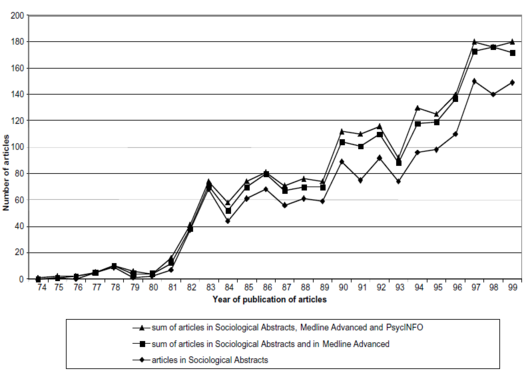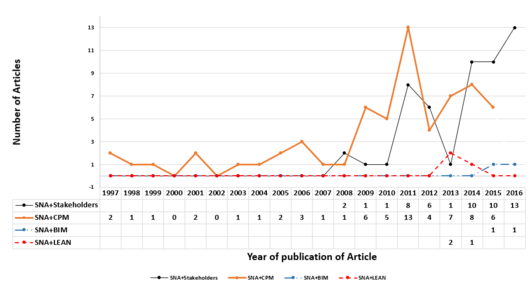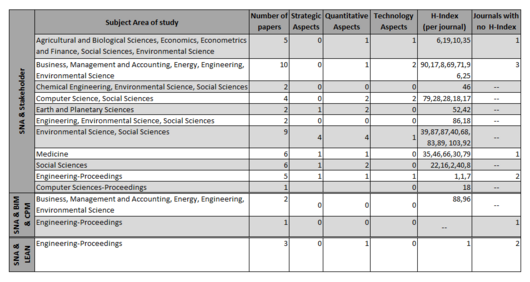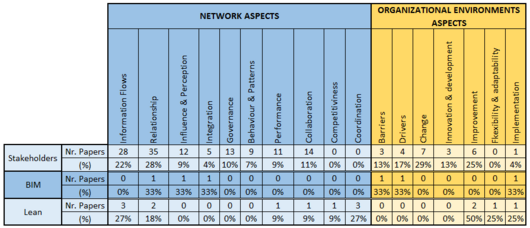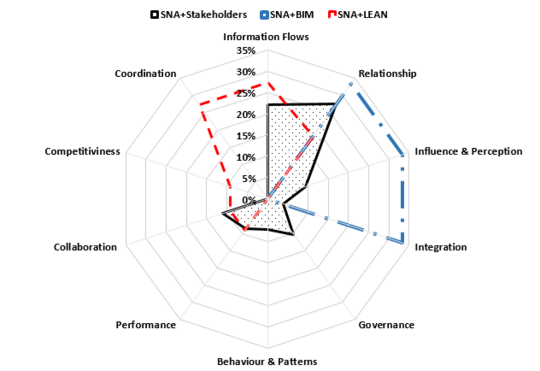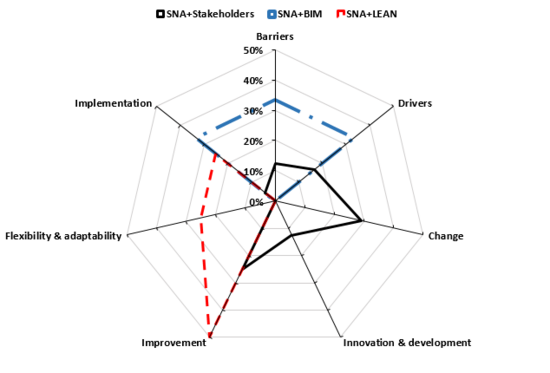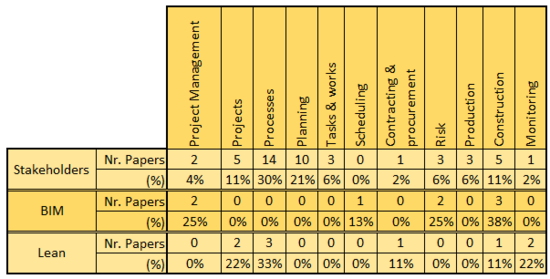Social Network Analysis-Opportunities in PPPM
Developed by Arnaldo Landivar Taborga
Contents |
Summary
“Social Network Analysis” (SNA) appears recently as a technique that explore, maps and measure data & information flows and relationship between organizations, groups, people or other entities.
The aim of this article is to explore and investigate the existing use of “Social Network Analysis” in projects with collaborative environments, such as BIM and/or Lean Construction projects.
Stakeholders has a prominent influence in the development of any type of project, their perspective was also included in order to obtain a broad overview of the state of the art in the use of “Social Network Analysis” techniques.
The article provides an overview of the current interests and study areas, identifying research opportunities related with “Performance” and “Collaboration” aspects that have been insufficiently studied.
Introduction
Construction productivity have been a classic concern in the Building Industry, Teicholz research present a negative growth in the period 1964-2012 [1], the most likely reasons behind this situation may be the highly fragmented project workflows, procurement systems based on competitive rather than collaborative teams, paper-based project delivery systems (PDS) with a low use of technology in their processes affecting the flow of data and information between the stakeholders creating conflicts and lowering the quality of the projects along all their life cycle.
With the introduction of CPM/PERT in 1958’, the use of technology has been gradually extended in the Project Management discipline [2], but is not until the past decade when their use is being more extensive, the evolution of the technology applied in projects is transforming the Building Industry moving from a paper-based towards a BIM-based type of projects shifting to a lean collaborative processes [3] [4].
Since 2000’s it has been observed a continuous growth of complexity in projects[5][6]caused by the increasingly use of technology, project size/scale, construction methods, stakeholders diversity and overlapping processes in the life cycle of a project, as a result Project Managers have been facing an increase of challenges at strategic, organizational and human resources level[7].
Projects are team-based developed, currently, as a result of the technological advancements projects are producing an immense amount of data, sorting useful data to transform in coordinate and productive information that flows through all the processes along the life cycle of a project is crucial in their success.
Social Network Analysis(SNA)
Introduction & Historical evolution
Organizations are composed by individuals and, based in their ranks, assembled in different groups organized in a hierarchical structure. Work activities and tasks constitutes the main interaction type between these individuals establishing a formal network.
However, within the same organization, interaction between individuals could be based in their work-space proximity, nationality, sport preference, etc. in this case creating different groups and establishing an informal network.
Individuals and organizations are the main actors from either formal or informal structures and as a result of their interaction within a network (intra-organizational) or with other networks (inter-organizational), different behavior patterns and influential actors could be identified, the analysis of these network dynamics constitutes the object of study of Social Network Analysis (SNA).
According Freeman the historical evolution of SNA comprises the following periods [8][7]:
1. Everything before 1929, focused on the interaction and relationship between actors
2. From 1929 to 1939, focused in a systematic collection of data between this actors
3. From 1940 to 1969, with the introduction of graph theories
4. From 1970 until now, the modern era based on the use of mathematical/computational tools to analyse these interactions
In the past years with the birth of internet and the technological advancements, SNA gained relevance; research studies have been reformulated and reconsider their approach, being the use of network studies an important part, not only, of sociological studies but also incorporated as a strategy used by different disciplines [9][8] (Figure 1).
Organizations are open systems [10], and as individuals could be influenced by internal or external changes in the organizational environment and at the same time the interconnection between systems or individuals could be altered as a result of the above mentioned changes.
Through "Social Network Analysis" this changes and their impact in individuals and/or organizations could be studied, and depending on the network type, cohesive or bridging the effect and the propagation of the changes would be different.
The interconnection between all actors in a cohesive networks provides mutual support and trust and facilitates coordination and communication[11].
Therefore, in order to identify an asses research opportunities in the use of Social Network Analysis in collaborative environments, a review of papers and/or articles was conducted with special attention on network and organizational aspects.
Methodology
An structured approach was adopted, in the articles review:
• Search process, different iterations and combination of key words were conducted, the final retrieved articles were consequence of a refine process.
• Distribution of articles per year
• List of journals and account of articles included in each journal
• Categorization of the articles by subject area of study
• Analysis of the abstracts of the retrieved articles, identification of key words an aspects
The following common keywords were considered in the initial search, “Social Network”, “Social Network Analysis” “Stakeholder”, “BIM”, “Lean Construction”, “Engineering Systems”, “Construction Project Management”.
Search process
First iteration, through “DTU Findit” database an initial search of articles was conducted with “Social Network” and “Social Network Analysis” as keywords, the total amount of entries founded were 113.043 and 1.890 respectively.
In a first view of the searched articles it was noticed that “SNA” was used as keyword in “Social Network Analysis” articles and, in many cases, “Social Network” was referred in “Social Media” articles.
To refine the search “Social Network” was discarded.
A second iteration with the keyword “Social Network Analysis” and the operator “AND” in a successive combination with the keywords “Stakeholder”, “BIM”, “Lean Construction” was conducted, the total amount of entries founded were 2.297, 2 and 5 respectively.
It was observed that within the search “Social Network Analysis AND Stakeholder” there was still some entries referred to “Social Media”; with the search of “Social Network Analysis AND BIM” the entries corresponded with the intended search and with the search of “Social Network Analysis AND Lean Construction” there was 2 entries that corresponded with medicine subject areas.
A third iteration was conducted, the prefix “ab: abstract” and the operator “AND” were selected in the formula “ab: (SNA) AND Stakeholder”, a total 63 entries were obtained, 8 entries corresponded with repeated articles in different journals, 2 entries matched with the entries founded in the search “Social Network Analysis AND BIM” and 1 entry corresponded with one paper that reviewed the status of research SNA in construction project management context (CPM) that is coincident with the aim of this article.
Findings
Based in the combination of keywords used in the search the following papers were retrieved:
• Search area “Social Network Analysis AND Stakeholder”, 52 papers, from now on will be referred in tables or figures as “SNA + Stakeholder” or “Stakeholder”
• Search area “Social Network Analysis AND BIM”: 2 papers, from now on will be referred in tables or figures as “SNA + BIM” or “BIM”
• Search area “Social Network Analysis AND Lean Construction”: 3 papers, from now on will be referred in tables or figures as “SNA + Lean” or “Lean Construction” or “Lean”
• One paper retrieved in the search area “SNA + Stakeholder” was assigned with its own search area “Social Network Analysis and Construction Project Management”, from now on will be referred in tables and figures “SNA +CPM” or “CPM”
This paper is a review of 63 studies in a CPM context published in the period 1997-2015[12]
The distribution of papers by year can be seen in figure 2.
The analysis of the retrieved papers shows different aspects of interests that have been grouped in following categories:
Group 1.Publication contribution, to determine the publication that contributed the most, the amount of papers produced by every journal was accounted, a categorization by the main subject areas of study and the index of research of impact was also included
It was observed that from the 58 retrieved journals, 10 papers were published in the context of different proceedings, the rest of papers were published in 43 journals.
Group 1.1, journals that published more than 1 paper with an h-index over 90:
• Journal of Cleaner Production with 2 from UK with “Business, Management and Accounting, Energy, Engineering, Environmental Science” as subject area with an h-index of 96
Group 1.2, journals that published more than 1 paper (+ paper from group 1.1):
• Ecology and Society with 3 papers from Canada with “Environmental Science” as subject area with an h-index of 87
• Journal of Environmental Planning and Management with 2 papers from UK with “Chemical Engineering, Environmental Science, Social Sciences” as subject area with an h-index of 46.
• International Journal of Information Technology and Decision Making with 2 papers from Singapore with “Computer Science” as subject area with an h-index of 28
Group 1.3, journals that published papers with an h-index of 90 or above (+ paper from group 1.1):
• Global Environmental Change with 1 paper from UK with “Environmental Science, Social Sciences” as subject area with an h-index of 103
• Waste Management with 1 paper from UK with “Environmental Science” as subject area with an h-index of 92
• Industrial Marketing Management with 1 paper from USA with “Business, Management and Accounting” as subject area with an h-index of 90
Group 2.Type of research, qualitative or quantitative, all the papers have a qualitative approach however in regards of the quantitative type, the papers that even though has not explicit mention of the quantitative aspect or intended to measure some of the results obtained in their studies were included.
The distribution of papers based on the type of research were:
• Qualitative, 58 papers (100%)
• Quantitative, 15 papers (26%)
Group 3.Organizational level aspects, such as strategic, tactical or operational in this category 8 papers (14%) had explicit mention of the strategic value of the paper, it is assumed that the rest of papers covers also the tactical and the operational levels.
Table 1 shows a summary of group 1, 2 , 3, 7.
Table 2 shows a summary of group 4, 5.
Group 4.Network aspects, the aspects that could have an influence and affect the equilibrium in this systems have been included in this category. The following list shows aspects that were grouped in one item:
• Information Flows= Data flows, Knowledge flows, communication
• Relationship= Connectivity, Inter-connectivity
• Collaboration= Sharing, shared information, shared data, shared knowledge, cross-functional collaboration, Big room
• Performance= Team performance, Individual performance, measurements, efficiency, productivity
Group 5.Organizational environment aspects, in this category were grouped all the aspects that could have an impact on the equilibrium of an individual or in an organization network.
Impediment aspects were grouped with Barriers as one item.
Group 6.Project Management aspects, in this category were grouped all the concepts that were related with the discipline of Project Management (PM), based on PMBOK 5th edition () standard, initially it was intended to allocate the concepts to each knowledge domain, however as many aspects could be referred to more than one domain this intent was discarded.
Table 3 shows a summary of group 6.
Group 7.Technological aspects, within this aspect different concept were consider and grouped as follows:
• Technology= Technology, Internet, Web-based, Knowledge Management Systems (KMS)
Other aspects such as "Waste" and "Value generation" were found only on the "SNA + Lean" searched area.
Discussion
Papers distribution over time. The yearly distribution of published papers in the period 1974-1999 from the area “SNA + Computer Sciences” displayed in Figure 1 shows a clear progression in the interest of this type of studies.
In Figure 2, two distinctive groups has been identified, the first comprise “SNA + Stakeholder” and “SNA + CPM” searched areas with an interest over 19 and 8 years respectively, it has been observed in both cases a discontinuous progression of publications with a pick of 13 published papers in 2011 in the “SNA + CPM” searched area and with only 1 published papers in 2013 in the “SNA + Stakeholder” searched area.
In the second identified group comprised by “SNA + BIM” and “SNA + Lean” searched areas it has been observed an initial interest in this type of studies since 2013 and 2015 respectively, it seems early to forecast any type of development.
Publication contribution.With a total of 43 journals and 9 conference proceedings distributed in 11 study areas supports the fact that there is an increasing interest of the this matter in different fields.
The journal that contributed the most was Ecology and Society with 3 papers from Canada within “Environmental Science” as subject area and with an h-index of 87.
“Business, Management and Accounting, Energy, Engineering, Environmental Science” was the subject area with most published papers, 10.
From an organizational level perspective only 8 (13%) over 58 published papers considered their strategic importance.
Based on the type of research, all the papers have had a qualitative approach, but only 15 (26%) had considered a quantitative approach or tried to measure some of the aspects in which the study was conceived, coincident most of the cases in some way to measure any type of performance.
In regards of technological aspects, 5 (9%) over 9 (16%) papers that considered this aspect have been using internet or web-based solutions to support their studies and from this 5 papers only 3 (5%) have had a quantitative approach to measure their results.
In regards of the network aspects, the figure 3 shows a clear distinction between the interests of “SNA + BIM” and “SNA + Lean” searched areas, however both shared an interest in the “Relationship” aspect.
“SNA + Lean” papers have been focus more in the “Coordination” and “Information flows” and “SNA + BIM” papers were more interested in “Integration” and “Influence & perception” aspects.
In the case of “SNA + Stakeholder” searched area the interest was focused with “Information flows“ and “Relationship” aspects.
In all the cases, it was observed that “Governance”, “Behaviour & Patterns”, “Performance”, “Collaboration”, “Competitiveness” aspects have received insufficient investigation.
In the case of organizational environment aspects the interest were different between each searched area.
“SNA + Lean” papers were interested in “Improvement”, “Flexibility & adaptability” and “Implementation”, this last aspect was also common for “SNA + BIM” papers that was also interested in “Barriers” and “Drivers” aspects.
“SNA + Stakeholder” papers had a more disperse interest being “Change” and “Improvement” aspects the most important considered in this group of aspects.
Conclusion
One of the objectives when establishing the searched areas was to identify the different study areas in which the use of SNA techniques has an interest and which journal contributed the most in the available literature.
With a total of 43 journals and 9 conference proceedings distributed in 11 study areas supports the fact that there is an increasing interest of the this matter in different fields.
It has been proved the interest in the field of "Construction Project Management", however in the case of collaborative environments (BIM and Lean Construction) the lack of studies in the use of "SNA" techniques is evident with only 4 papers in the past 4 years, and in all cases their focus more in the aspects related with "Information flows" and "Relationship" that has a qualitative component.
The building industry is experiencing an technological transformation that is affecting different fields, with different speeds in the adoption of this technological advancements depending on the organizations, currently internet and web-based solutions could considered one of the more extended technological advancements, however the article reveals a poor use of this technology with only 3% of their use in SNA techniques.
The insufficient studies in the "Performance" and "Collaboration" aspects are presented as potential opportunities for future research in PPPM domain.
One of the more interesting lines of research would be the use of SNA techniques to identify within project-team networks "Behavior & patterns" and measure "Collaborative" and "Coordination" aspects to find if there is any correlation with the project-team "Performance" and productivity.
Annotated Bibliography
Linton C. Freeman, The Development of Social Network Analysis: A Study in the Sociology of Science-Review, provides a short and concise overview of the development of "Social Network Analysis", (B. H.Rusell, 2005)
Review of the application of social network analysis (SNA) in construction project management research, provides a review of 63 papers in the aplication of SNA techniques in Construction Project Managemanet, (Zheng, Y. Le, A. P. C. Chan, Y. Hu, and Y. Li, 2016).
References
- ↑ P. Teicholz, “Labor productivity declines in the construction industry: causes and remedies (another look),” AECbytes Viewp., 2013.
- ↑ M. Kozak-Holland, “The History of Project Management,” Lessons from Hist., vol. 18, no. 4, p. 640, 2011.
- ↑ R. Soares, “Reengineering Management of Construction Projects,” Int. J. Bus. Soc. Sci., vol. 4, 2013.
- ↑ P. Teicholz, “Labor productivity declines in the construction industry: causes and remedies (another look),” AECbytes Viewp., 2013.
- ↑ V. R. Santos, António Lucas Soares, and J. Á. Carvalho, “Knowledge Sharing Barriers in Complex Research and Development Projects: an Exploratory Study on the Perceptions of Project Managers,” Knowl. Process Manag., vol. 19, no. 1, pp. 27–38, 2012.
- ↑ B. Xia and A. P. C. Chan, “Measuring complexity for building projects: a Delphi study,” Eng. Constr. Archit. Manag., vol. 19, no. 1, pp. 7–24, 2012.
- ↑ G. R. Jones and J. M. George, “Essentials of Contemporary Management,” Essentials of Contemporary Management, Fifth Edition, 2012.
- ↑ B. H.Rusell, “Linton C. Freeman, The Development of Social Network Analysis: A Study in the Sociology of Science-Review,” vol. 27, pp. 377–384, 2005.
- ↑ R. Rousseau and E. Otte, “Social network analysis: a powerful strategy, also for the information sciences,” J. Inf. Sci., vol. 28, no. 6, pp. 441–453, 2002.
- ↑ J. Hayes, The Theory and Practice of Change Management. Palgrave Macmillan, 2014.
- ↑ J. Battilana and T. Casciaro, “The network secrets of great change agents,” Harvard Business Review, pp. 62–68, 2013.
- ↑ X. Zheng, Y. Le, A. P. C. Chan, Y. Hu, and Y. Li, “Review of the application of social network analysis (SNA) in construction project management research,” Int. J. Proj. Manag., vol. 34, no. 7, pp. 1214–1225, Oct. 2016.
Appendix 1
In this section are listed all the documents used in the tables and figures.
On September the 17th “DTU Findit” database has been used for search documents that lately are used in the conformation of tables and figures.
A first search with the phrase “Social Network” was used with a total of 113043 entries.
A second search with the phrase “Social Network Analysis (SNA)” was used with a total of 1890 entries.
The prefix “ab: abstract” and the operator “AND” were selected for a third search on the formula “ab: (SNA) AND Stakeholder” with a total 63 entries, 3 entries corresponded to repeated papers, finally a total of 60 documents were retrieved.
[1]C. Prell, K. Hubacek, C. Quinn, and M. Reed, “‘Who’s in the network?’ When stakeholders influence data analysis,” Syst. Pract. Action Res., vol. 21, no. 6, pp. 443–458, Dec. 2008. [2]S. Yang and L. Huang, “Web mining as a valuable tool in technology commercialization potential evaluation,” in 2008 International Conference on Wireless Communications, Networking and Mobile Computing, WiCOM 2008, 2008. [3]D. Vandenbroucke, “A Network Perspective on Spatial Data Infrastructures: Application to the Sub-national SDI of Flanders (Belgium),” Trans. Gis, vol. 13, no. s1, 2009. [4]D. Vandenbroucke, J. Crompvoets, G. Vancauwenberghe, E. Dessers, and J. Van Orshoven, “A network perspective on spatial data infrastructures: Application to the sub-national SDI of flanders (Belgium),” in Transactions in GIS, 2009, vol. 13, no. SUPPL. 1, pp. 105–122. [5]G. F. Secundo G., “Designing, managing and assessing a {Web} 2.0 learning community to enhance inquiry based learning,” Int. J. Web Based Communities, vol. 6, no. 2, pp. 164–182, 2010. [6]Ö. Bodin, “Social Networks and Natural Resource Management: Uncovering the Social Fabric of Environmental Governance,” Soc. Networks Nat. Resour. Manag. Uncovering Soc. Fabr. Environ. Gov., pp. 1–374, 2011. [7]Y. M. Chen and M.-Y. Chen, “Social network analysis aided product development project management: IC Substrates case study,” Manag. Sci. Lett., vol. 1, no. 2, pp. 107–114, Apr. 2011. [8]I. H. El-adaway, “Relational contracting and high-performance project outcomes,” in Proceedings, Annual Conference - Canadian Society for Civil Engineering, 2011, vol. 3, pp. 1946–1955. [9]F. G., T. F.W., and A. D., “Infectious syphilis in New Brunswick: Using data for action in a small Canadian province,” Sex. Transm. Infect., vol. 87, p. A354, 2011. [10]K. Sedereviciute and C. Valentini, “Towards a More Holistic Stakeholder Analysis Approach. Mapping Known and Undiscovered Stakeholders from Social Media,” Int. J. Strateg. Commun., vol. 5, no. 4, pp. 221–239, Oct. 2011. [11]C. Stein, H. Ernstson, and J. Barron, “A social network approach to analyzing water governance: The case of the Mkindo catchment, Tanzania,” Phys. Chem. Earth, vol. 36, no. 14–15, pp. 1085–1092, Jan. 2011. [12]K. Vance-Borland and J. Holley, “Conservation stakeholder network mapping, analysis, and weaving,” Conserv. Lett., vol. 4, no. 4, pp. 278–288, Aug. 2011. [13]G. Woodill, D. Ed, S. Analyst, S. Wright, and M. I. St, “Improving Knowledge Flow in Organizations in Organizations,” 61st Annu. Iie Conf. Expo Proc., no. March, 2011. [14]C. Crisostomo, M. R. Bteich, H. Moschitz, and P. Pugliese, “Organic farming policy in Portugal: Analysis of the policy network,” in New Medit, 2012, vol. 11, no. 4 SPECIAL, pp. 27–30. [15]M. de Miguel Molina, “Proposed use of social network analysis of public policies for the integration of the Unaccompanied Foreign Minors (UFM). Study of the case of the Valencia Region. Propuesta de uso del análisis de redes de actores de políticas públicas para la gestión de,” Rev. Sobre La Infanc. Y La Adolesc., 2012. [16]H. Doloi, “Assessing stakeholders ’ influence on social performance of infrastructure projects,” Facilities, vol. 30, no. 11, pp. 531–550, Aug. 2012. [17]T. L. Frantz, “Advancing complementary and alternative medicine through social network analysis and agent-based modeling.,” Forsch. Komplementarmed., vol. 19, no. suppl 1, pp. 36–41, 2012. [18]A. Herrero Blasco, “Propuesta de uso del análisis de redes de actores de políticas públicas para la gestión de la integración de los Menores Inmigrantes No Acompañados (MINA). Estudio del caso de la Comunidad Valenciana Proposed use of social network analysis of public polic,” Rev. Sobre La Infanc. Y La Adolesc., 2012. [19]N. Meese and C. McMahon, “Analysing sustainable development social structures in an international civil engineering consultancy,” J. Clean. Prod., vol. 23, no. 1, pp. 175–185, Mar. 2012. [20]C. B. Wonodi, L. Privor-Dumm, M. Aina, A. M. Pate, R. Reis, P. Gadhoke, and O. S. Levine, “Using social network analysis to examine the decision-making process on new vaccine introduction in Nigeria,” Health Policy and Planning, vol. 27, no. SUPPL.2. pp. ii27–ii38, 01-May-2012. [21]F. Solis, J. V. Sinfield, and D. M. Abraham, “Hybrid Approach to the Study of Inter-Organization High Performance Teams,” J. Constr. Eng. Manag., vol. 139, no. April, pp. 379–392, Apr. 2013. [22]M. Caniato, M. Vaccari, C. Visvanathan, and C. Zurbr??gg, “Using social network and stakeholder analysis to help evaluate infectious waste management: A step towards a holistic assessment,” Waste Manag., vol. 34, no. 5, pp. 938–951, May 2014. [23]H. Doloi, “A framework for supporting planning and development of infrastructure projects from a societal perspective,” in 31st International Symposium on Automation and Robotics in Construction and Mining, ISARC 2014 - Proceedings, 2014, pp. 904–909. [24]M. Furmankiewicz, ??ine Macken-Walsh, and J. Stefa??ska, “Territorial governance, networks and power: Cross-sectoral partnerships in rural Poland,” Geogr. Ann. Ser. B Hum. Geogr., vol. 96, no. 4, pp. 345–361, Dec. 2014. [25]S. Gretzinger, S. Lemke, and W. Matiaske, Managing Human Resource Based Intellectual Capital in a Global Setting: the Impact of Cultural Practices on the Effectiveness of Retention Incentives. Academic Conferences Publishing International, 2014. [26]D. Jarman, E. Theodoraki, H. Hall, and J. Ali-Knight, “Social network analysis and festival cities: an exploration of concepts, literature and methods,” Int. J. Event Festiv. Manag., vol. 5, no. 3, pp. 311–322, Oct. 2014. [27]S. F. M. Nogueira and J. C. M. R. Pinho, “Examining tourism stakeholder networks and relationship quality: The specific case of peneda gerês national park (PNPG),” Rev. Port. Estud. Reg., vol. 36, no. 1, pp. 22–33, 2014. [28]H. Quang, X. Shen, and A. Akbarnezhad, Proceedings of the 31st International Symposium on Automation and Robotics in Construction and Mining : ISARC 2014 theme : automation, construction and environment. 2014. [29]R. K. Shepherd and S. D. Pryke, “Regional rail planning; a study of the importance of ‘steering’ and ‘pragmatism’ in stakeholder networks,” Eur. Manag. J., vol. 32, no. 4, pp. 616–624, Aug. 2014. [30]R. Taylor, J. Forrester, L. Pedoth, and N. Matin, “Methods for Integrative Research on Community Resilience to Multiple Hazards, with Examples from Italy and England,” Procedia Econ. Financ., vol. 18, pp. 255–262, 2014. [31]R. J. Yang, “Stakeholder-associated risk networks in green buildings: China Versus Australia,” Proc. 30th Annu. Assoc. Res. Constr. Manag. Conf. Arcom 2014, 2014. [32]R. J. Yang and P. X. W. Zou, “Stakeholder-associated risks and their interactions in complex green building projects: A social network model,” Build. Environ., vol. 73, pp. 208–222, Mar. 2014. [33]L. Calvet-Mir, S. Maestre-Andrés, J. L. Molina, and J. van den Bergh, “Participation in protected areas: A social network case study in catalonia, Spain,” Ecol. Soc., vol. 20, no. 4, p. art45, 2015. [34]D. Contandriopoulos and C. Larouche, “009 op: a sociogram is worth a thousand words: proposing a method for the visual analysis of narrative data,” BMJ Open, vol. 5, no. 4, p. UCLSymposiumAbstracts9, Apr. 2015. [35]E. A. Cudney, S. M. Corns, and S. K. Long, “Improving knowledge sharing in healthcare through social network analysis,” Int. J. Collab. Enterp., vol. 4, no. 1/2, p. 17, 2015. [36]E. A. Cudney, S. M. Corns, and S. K. Long, “Improving knowledge sharing in healthcare through social network analysis,” Int. J. Collab. Enterp., vol. 4, 2015. [37]H. Doloi and B. Raphael, “Drivers And Impediments Of Building Information Modelling From A Social Network Perspective,” in 32nd International Symposium on Automation and Robotics in Construction and Mining: Connected To the Future, Proceedings, 2015. [38]J. Georis-Creuseveau, “Analyse de réseaux sociaux des usages des Infrastructures de Données Géographiques Le cas des acteurs coˆtiers en France et des IDG qu’ils Mobilisent,” CEUR Workshop Proc., vol. 1535, 2015. [39]J. Hauck, C. Stein, E. Schiffer, and M. Vandewalle, “Seeing the forest and the trees: Facilitating participatory network planning in environmental governance,” Glob. Environ. Chang., vol. 35, pp. 400–410, Nov. 2015. [40]G. Hosseininia, P. R. Khachak, M. Nooripoor, S. Van Passel, and H. Azadi, “Understanding communicational behavior among rangelands’ stakeholders: application of social network analysis,” J. Environ. Plan. Manag., vol. 59, no. April, pp. 1–22, Feb. 2015. [41]C. Z. Li, J. Hong, F. Xue, G. Q. Shen, X. Xu, and M. K. Mok, “Schedule risks in prefabrication housing production in Hong Kong: A social network analysis,” Journal of Cleaner Production, vol. 134, pp. 482–494, Oct-2015. [42]W. Lyles, “Using social network analysis to examine planner involvement in environmentally oriented planning processes led by non-planning professions,” J. Environ. Plan. Manag., vol. 58, no. 11, pp. 1961–1987, Nov. 2015. [43]M. Petrescu-Prahova, B. Belza, K. Leith, P. Allen, N. B. Coe, and L. A. Anderson, “Using Social Network Analysis to Assess Mentorship and Collaboration in a Public Health Network,” Prev Chronic Dis, vol. 12, no. 8, p. E130, Aug. 2015. [44]K. Still, J. Huhtamaki, and M. G. Russell, “New insights for relational capital.,” Electronic Journal of Knowledge Management, vol. 13, no. 1. pp. 13–28, 2015. [45]A. von der Fehr, “Validation of Social Networks from a Snowball Sampling Study of Municipal Science Education Stakeholders,” Int. J. Res. Method Educ., 2015. [46]B. Yamkovenko and J. P. Hatala, “Methods for Analysis of Social Networks Data in HRD Research,” Adv. Dev. Hum. Resour., vol. 17, no. 1, pp. 40–56, Feb. 2015. [47]S. Badi, L. Wang, and S. Pryke, “Relationship marketing in Guanxi networks: A social network analysis study of Chinese construction small and medium-sized enterprises,” Ind. Mark. Manag., May 2016. [48]Ö. Bodin, A. Sandström, and B. Crona, “Collaborative Networks for Effective Ecosystem-Based Management: A Set of Working Hypotheses,” Policy Stud. J., p. n/a–n/a, Jan. 2016. [49]B. C. Chaffin, A. S. Garmestani, H. Gosnell, and R. K. Craig, “Institutional networks and adaptive water governance in the Klamath River Basin, USA,” Environ. Sci. Policy, vol. 57, pp. 112–121, Mar. 2016. [50]K. Ekker, “Emergency management training: Handling rich qualitative and quantitative data,” J. Intell. Fuzzy Syst., vol. 31, no. 2, 2016. [51]J. Georis-Creuseveau, C. Claramunt, and F. Gourmelon, “A modelling framework for the study of Spatial Data Infrastructures applied to coastal management and planning,” Int. J. Geogr. Inf. Sci., pp. 1–17, May 2016. [52]J. Hauck, J. Schmidt, and A. Werner, “Using social network analysis to identify key stakeholders in agricultural biodiversity governance and related land-use decisions at regional and local level,” Ecol. Soc., vol. 21, no. 2, 2016. [53]B. J. Kreakie, K. C. Hychka, J. A. Belaire, E. Minor, and H. A. Walker, “Internet-Based Approaches to Building Stakeholder Networks for Conservation and Natural Resource Management,” Environ. Manage., vol. 57, no. 2, pp. 345–354, Feb. 2016. [54]J. N. Lamb, K. M. Moore, J. Norton, E. C. Omondi, R. Laker-Ojok, D. N. Sikuku, D. S. Ashilenje, and J. Odera, “A social networks approach for strengthening participation in technology innovation: lessons learnt from the Mount Elgon region of Kenya and Uganda,” Int. J. Agric. Sustain., vol. 14, no. 1, pp. 65–81, Jan. 2016. [55]T. Luthe and R. Wyss, “Resilience to climate change in a cross-scale tourism governance context: a combined quantitative-qualitative network analysis,” Ecol. Soc., vol. 21, no. 1, p. art27, 2016. [56]T. A. Muñoz-Erickson and B. B. Cutts, “Structural dimensions of knowledge-action networks for sustainability,” Current Opinion in Environmental Sustainability, vol. 18. pp. 56–64, Feb-2016. [57]A. Paletto, J. Balest, I. Demeo, G. Giacovelli, and G. Grilli, “Power of Forest Stakeholders in the Participatory Decision Making Process: A Case Study in Northern Italy,” Acta Silv. Lignaria Hungarica, vol. 12, no. 1, pp. 9–22, Jan. 2016. [58]J. I. Romero Gelvez and M. Garcia-Melon, “Influence Analysis in Consensus Search — A Multi Criteria Group Decision Making Aproach in Environmental Management,” Int. J. Inf. Technol. Decis. Mak., vol. 15, no. 04, pp. 1–23, Jul. 2016. [59]W. Williamson and K. Ruming, “Using Social Network Analysis to Visualize the Social-Media Networks of Community Groups: Two Case Studies from Sydney,” J. Urban Technol., pp. 1–21, Jul. 2016. [60]X. Zheng, Y. Le, A. P. C. Chan, Y. Hu, and Y. Li, “Review of the application of social network analysis (SNA) in construction project management research,” Int. J. Proj. Manag., vol. 34, no. 7, pp. 1214–1225, Oct. 2016.
